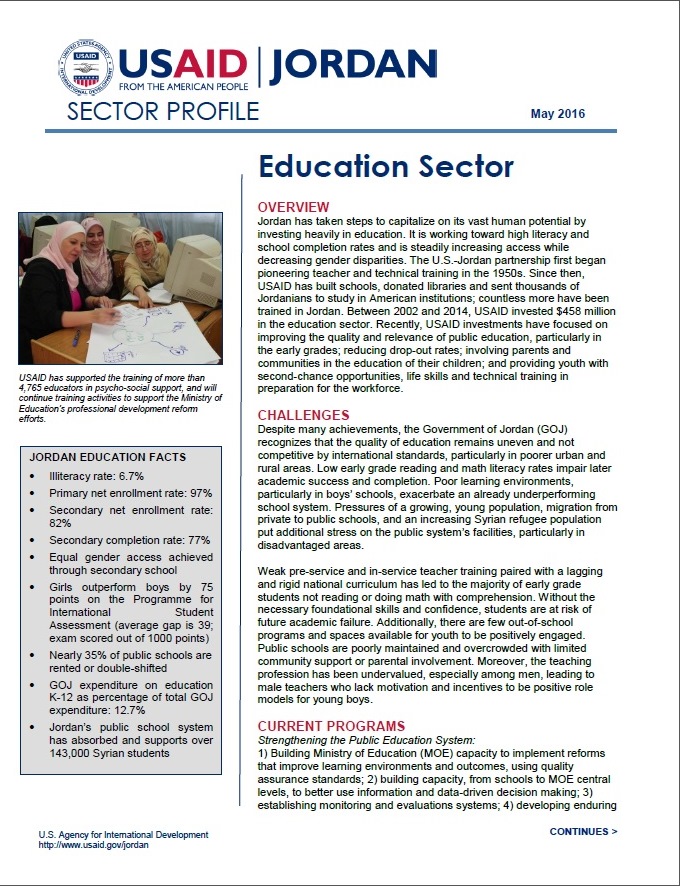
OVERVIEW
Jordan has taken steps to capitalize on its vast human potential by investing heavily in education. It is working toward high literacy and school completion rates and is steadily increasing access while decreasing gender disparities. The U.S.-Jordan partnership first began pioneering teacher and technical training in the 1950s. Since then, USAID has built schools, donated libraries and sent thousands of Jordanians to study in American institutions; countless more have been trained in Jordan. Between 2002 and 2014, USAID invested $458 million in the education sector. Recently, USAID investments have focused on improving the quality and relevance of public education, particularly in the early grades; reducing drop-out rates; involving parents and communities in the education of their children; and providing youth with second-chance opportunities, life skills and technical training in preparation for the workforce.
CHALLENGES
Despite many achievements, the Government of Jordan (GOJ) recognizes that the quality of education remains uneven and not competitive by international standards, particularly in poorer urban and rural areas. Low early grade reading and math literacy rates impair later academic success and completion. Poor learning environments, particularly in boys’ schools, exacerbate an already underperforming school system. Pressures of a growing, young population, migration from private to public schools, and an increasing Syrian refugee population put additional stress on the public system’s facilities, particularly in disadvantaged areas.
USAID/Jordan Education Sector May 2016 ![]() (pdf - 371k)
(pdf - 371k)
Weak pre-service and in-service teacher training paired with a lagging and rigid national curriculum has led to the majority of early grade students not reading or doing math with comprehension. Without the necessary foundational skills and confidence, students are at risk of future academic failure. Additionally, there are few out-of-school programs and spaces available for youth to be positively engaged. Public schools are poorly maintained and overcrowded with limited community support or parental involvement. Moreover, the teaching profession has been undervalued, especially among men, leading to male teachers who lack motivation and incentives to be positive role models for young boys.
CURRENT PROGRAMS
Strengthening the Public Education System:
- Building Ministry of Education (MOE) capacity to implement reforms that improve learning environments and outcomes, using quality assurance standards;
- building capacity, from schools to MOE central levels, to better use information and data-driven decision making;
- establishing monitoring and evaluations systems;
- developing enduring public-private partnerships; and
- promoting professionalism and recognizing excellence among teachers and other educators.
Improving Quality of Education and Learning Outcomes:
- Establishing a comprehensive professional teacher/administrator development system and policy framework;
- strengthening primary students’ reading and math skills in grades K-3;
- improving counseling and developing the skills of secondary school students to prepare them for higher education and future careers;
- promoting parent and community involvement; and
- creating positive opportunities for at-risk youth, such as non-formal education.
Improving Access to Education and Learning Environments:
- Building/expanding/renovating/refurbishing schools in underserved areas to alleviate overcrowding, ease the impact of the refugee influx, and improve the learning environment;
- addressing psycho-social aspects of the learning environment to make schools more engaging, healthy and safe; and
- involving parents and community members in schools to create a sense of ownership and responsibility among stakeholders within the public school system.
IMPACT & RECENT ACHIEVEMENTS
Recent USAID-supported achievements include:
-
Completed the construction and furnishing of 28 new schools with enhanced quality and learning features, as well as rehabilitated and expanded 117 existing public schools.
-
Improved the learning environment for more than 84,600 students attending 125 new or rehabilitated schools, and 12,180 kindergarten students in 609 renovated kindergarten classrooms.
-
Completed training for 20,000 educators in induction, in-service, leadership, and mentorship programs improving the quality of education for 200,000 children.
-
Supported 127 Community Parent School Committees across Jordan.
-
Enhanced the leadership and life skills of 130,000 youth who participated in school-to-career programs.
-
Renovated playgrounds and/or provided sports kits at 100 schools, and provided life skills activities serving more than 20,000 students.
-
Completed six high-quality policy-oriented studies through alliances with the National Center for Human Resources Development, resulting in broad dissemination and high-level policy dialogue.
-
Conducted learning environment improvement activities and teacher training in 120 schools in 11 field directorates in Jordan.
-
Leveraged $14 million in private-sector funds to benefit USAID-supported programs.
-
Completed a pilot early grade reading and math intervention that reduced the number of students unable to correctly answer a single reading comprehension question from 32 percent to 19 percent, and increased student success rates on conceptual math tasks from 5 percent to 24 percent.
Current Projects:
USAID Non-Formal Education Program
Early Grade Reading and Mathematics Project (RAMP)
Learning Environment: Improved Infrastructure Program (LEIIP)









Comment
Make a general inquiry or suggest an improvement.